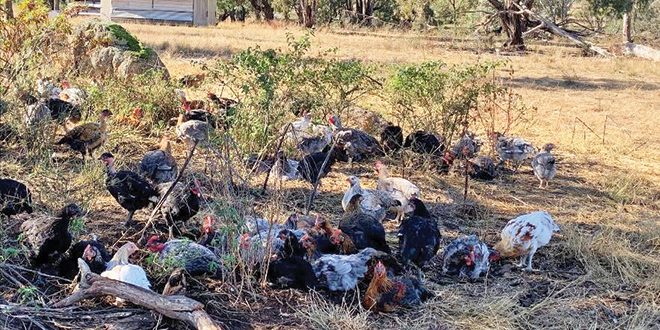Sunday mornings I lay in bed listening to Background Briefing on ABC Radio National. Sommerlad
Investigative narrative journalism at its best, it doesn’t shy away from tackling rural issues and gently coaxes you to think deeply about the subject it covers deeply over a half hour or so. By way of contrast, my working week starts by waking up alongside – not literally – Patricia Karvelas on RN Breakfast for what’s much more hardcore.
Anyway, on a recent cold wintery Sunday morning here in Western Australia, I was wrapped in my doona and rapt in the story covered on Background Briefing. Essentially, it was about the bureaucratic barriers faced by small-scale livestock producers, with a focus on chicken farmers. It also featured upfront Michael Sommerlad – the doyen of pasture-raised purpose-bred chickens and the ethical farming thereof. I’ve referenced him and his eminently edible Sommerlad chickens in this column before.
I was first alerted to the man and his flock when reading The Ethical Omnivore by Laura Dalrymple and Grant Hilliard of Sydney’s Feather and Bone butchery fame.
They describe Sommerlad chickens thus, “Unlike the white broiler chickens that struggle to remain agile after eight weeks – let alone cross the road – Sommerlad birds are a riot of colour and are built to run, hunt and explore, with long strong legs and powerful feet.”
“Slower growing, athletic and selectively bred over 15 years to thrive in the Australian climate.”
So, back to Background Briefing. Below is most of what went to air and pricked my ears the other Sunday.
In the 1970s, on the family farm in Tenterfield, a young boy named Michael Sommerlad dreamt of raising the ideal chicken. He was conscious of the way nature helps itself – “I consider my father one of the genuine environmentalists,” Michael said.
“He was able to look at his surroundings holistically to try to work his agricultural practices with what nature was providing.”
Michael spent his childhood observing the variety of characteristics across the diverse breeds of his farmyard chickens, fascinated by the way they interacted with the Australian environment. His dream was to make the perfect chicken for Australian conditions. That vision would see him not only breed chickens faster than his father but become an expert consultant on chicken genetics. And his dream was realised … until he was confronted with an industry resistant to change.
When his father was forced to sell his farm, Michael decided to join the commercial industry. The experience was a stark contrast to the birds he raised throughout his childhood.
“It was interesting for me, having that background to see how divorced modern commercial production was from that diversity,” he said.
“I still recall the day I walked into that first breeder shed and was presented with 11 or 12,000 birds in a 130-metre long shed.”
“They all looked almost identical.”
Michael thought he was going to faint – “It was a violent shock to the system.” He said that while the conventional industry has fine-tuned the production of cheap animal protein for the public, he was uncomfortable with the birds’ behaviour.
They lacked the natural instincts he was used to – to run, hunt and forage in the wild.
The two commercial meat breeds in Australia – Ross and Cobb – had been genetically fine-tuned through selective breeding to the point where they couldn’t perform the way nature intended outside.
“I have a set of values and ideals around how animals should be treated,” Michael said.
“I mean, if we’re going to eat something, if we’re going to take something’s life and eat it, I believe that it should be afforded certain respect.
“I wanted to see optimal animal welfare outcomes, not acceptable animal welfare outcomes.
“So, in the end, my wife and I decided to bite the bullet.
“And we started down the path of developing our own bird.”
Michael travelled across Australia, visiting poultry farms and hand-picking a variety of chickens based on characteristics that would flourish in the heat of northern Queensland and weather the winters of Hobart.
“There were actually nine different characteristics, and I used 12 to 15 strains of breeds from all over Australia,” he said.
Like a chicken detective, Michael would examine each breed’s rate of feathering, leg length and chest width.
“Diversity is the key in any sustainable ecosystem or environmental situation,” Michael said.
“The gene pool has to be broad and deep enough to be able to respond to challenges that we haven’t yet faced.”
Equipped with his genetic recipe for a perfect Australian chicken, he approached major figures in the industry. But he said he was stonewalled.
“On every occasion, my approaches were pooh-poohed out of hand as unnecessary,” Michael said.
A handful of small-scale producers embraced his vision and began raising his chickens. But they too hit roadblocks. They were trying to improve the industry, but state regulation got in the way.
“I have seen both at a state and local level where matters of interpretation have, in the best-case scenario, slowed things down… worst-case scenario, stopped them altogether,” he said.
Milking Yard Farm in central Victoria is one of those worst-case scenarios. Four months ago, the heritage-breed producers sold the last of their Sommerlad chickens to the public. They were one of the first farms in Australia to raise Michael Sommerlad’s chickens. Milking Yard Farm began eight years ago when Bruce Burton, a former air force pilot, was determined to raise chickens ethically in the forest that backed onto his property.
“We needed to find a breed or type of chicken that would be amenable to living in its natural habitat, because that’s what the forest is – its natural habitat,” he said.
Bruce took inspiration from France, where the Bresse chicken lives for up to 12 months, giving the bird a rich and deep taste.
“It was sort of like being slapped in the face with flavour.”
He was looking for birds to raise slowly, meaning they’re processed at roughly 10 to 12 weeks, instead of four weeks like the commercial birds. He was eventually put in touch with Michael Sommerlad.
“The first thing we noticed was how survivable they were in that very critical first four weeks,” Bruce said.
When Bruce had tried to raise the commercial varieties, he’d lost almost half of his flock. But he only lost 4 percent of the Sommerlad breed.
After running all the costs while operating at small-scale, he had to charge roughly 10 times more than a supermarket bird.
“We didn’t even know if people would like the flavour or the taste,” he said.
To Bruce’s surprise, consumers were eagerly buying his chickens throughout Victoria. Then, Bruce ran into a problem with his processing facility – they were scaling up.
“They said, ‘Look, we’re growing at such a rate, we simply can’t let you use the boning room,’” Bruce said.
He would have to find a new facility to process his chickens.
Small-scale farmers from across Victoria say the lack of access to abattoirs is costing them their livelihood.
In the entire state of Victoria, only one abattoir will accept small-scale contracts and their automated chain doesn’t cater to the variety of sizes in the Sommerlad breed.
So, Bruce was at a crossroads – shut up shop or build his own abattoir – which would cost about $500,000. Victorian regulator PrimeSafe would have oversight of the facility that would cost him a fortune.
Food safety regulation in Australia tightened in the early 2000s, following an e coli outbreak that led to the death of a four-year-old in South Australia and a hepatitis A outbreak that affected 400 people in NSW.
In Victoria, the Meat Authority was overhauled and, by 2003, had been completely replaced by a new body – PrimeSafe. PrimeSafe became the sole authority regulating the production of meat and seafood in the state.
In the eye of the regulator, small-scale producers became the biggest potential risk area because they often didn’t understand the rules or couldn’t afford to employ food-safety officers.
“We’d been hearing from a lot of people who’d started building abattoirs or boning rooms that the compliance requirement was terribly onerous,” Bruce said.
“And that the regulator was draconian and heavy-handed and applied these regulations that were not appropriate to small-scale farms.”
So, Bruce closed his business and Sommerlad chickens became inaccessible in Victoria.
And there you have it, straight from Background Briefing – battling bullying bureaucracies has become a sad way of life for small livestock producers and the consuming public is typically the loser. And that’s not right, because it’s the public who pay the taxes to fund the bureaucrats.
A close look at the names that make up the boards of such influential bodies usually reveals a liberal dose of powerful ‘big boys’ and maybe a few ‘big girls’, but typically no ‘little boys’ or ‘little girls’.
Brendon Cant

